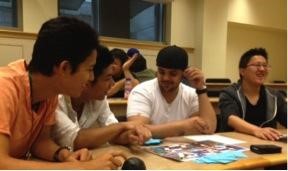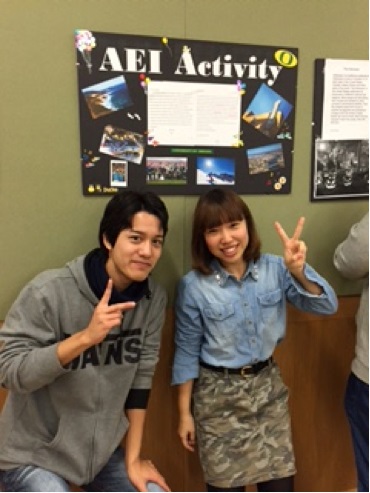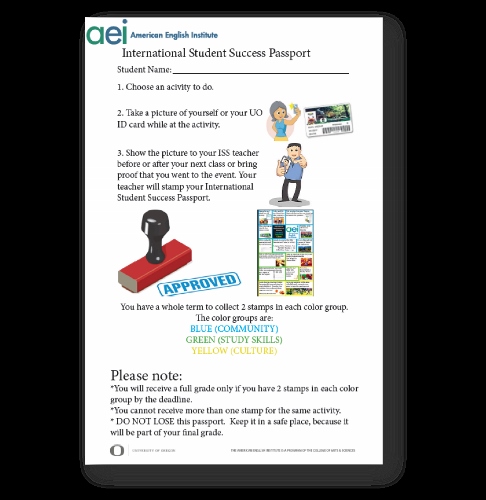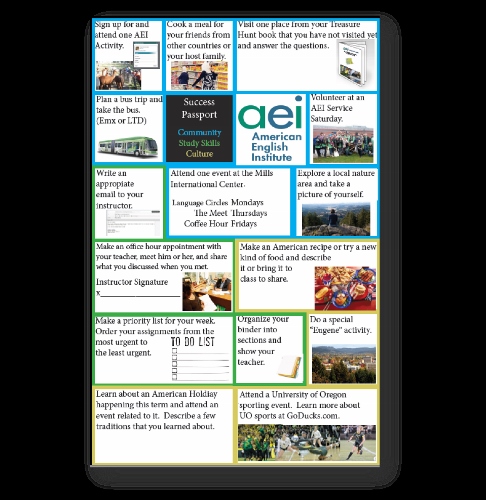|
Introduction
How many times have you wished your students would write more
culturally appropriate emails? Or that they would remember the
time-management strategies and attendance policies explained during
orientation?
In order to support nonmatriculated students through their
cultural transition, the University of Oregon’s American English
Institute (AEI) has created an ongoing orientation course. This
mandatory, faculty-led course meets 2 hours weekly for the full 9-week
term, and has helped hundreds of students successfully navigate this
challenging transition process.
Rationale
Ongoing orientations have been shown to improve attendance,
academic performance, and retention (Iwasko, Keisler, &
Cunningham, 2012; Reynolds, 2010; Sayrs,1999). Additionally, we were
hopeful that implementing such a course would lead to fewer student
complaints, as well as reduce the class time that teachers were spending
on developing students’ basic study skills. The Commission on English
Language Program Accreditation also requires IEPs to offer ongoing
orientation, although it does not specify a delivery format (p.9, CEA, 2015) .
Needs Analysis
At AEI, there is an academic advisor referral system where
teachers can refer students for problematic behavior. As an associate
academic advisor, I help with the consultations and assist students in
learning strategies to help them avoid making similar mistakes. By
tracking data from these referrals and by researching best practices, we
were able to determine the common academic issues IEP students
experience. The common reasons for referrals have been:
- academic misconduct
- excessive absence and tardiness
- being disrespectful in class
- no or late homework
- coming to class unprepared
- using cell-phone in class
Also, the topics frequently discussed at referral meetings included:
- expectations and strategies (academic expectations, time
management skills, working with teachers and tutors),
- academic policies (probation and disqualification policies,
student conduct procedure, policies on religious holidays),
and
- campus resources (Health Center, Counseling Center, Housing Office, drop-in tutor sessions)
- in addition, we collected input from teachers and staff members
via an online survey and several discussion sessions. From these we
learned that the issues listed above were indeed sources of concern.
Thus, the issues identified in this needs analysis were incorporated in
the course design.
Logistics
The next phase was to have multiple discussions with administrators to work out the logistics.
Class enrollment: We decided that all
incoming, full-time students would be required to take this orientation
course, which we named International Student Success (ISS), grouped by
levels. This format was chosen in order to reach out to the most at-risk
students who likely would not register for a class if it were optional.
Academic policies: Attendance is required,
and absences count toward probation and disqualification from the IEP.
Schedule: Because of scheduling constraints,
ISS classes are scheduled at the same time as students’ elective
classes. If a student chooses to take an elective at the time they are
enrolled in ISS, we switch their ISS section so that they can take
both.
Curriculum
The course focuses on four main areas: cultural adjustment,
study skills, integration to community, and personal development. See
Table 1 for a brief overview of the weekly schedule.
Table 1. Weekly Schedule Overview
|
Week |
Themes |
Activity Highlights |
|
1 |
Introduction to ISS |
Introduction to class and Success Passport* |
|
2 |
Campus resources |
Campus tour with teachers and
in-class tutors. Discuss questions about campus
resources. |
|
3 |
Community resources |
Resource Fair: In groups, read
scenarios on various issues. Find helpful information from a collection
of campus/community pamphlets that are presented in class. Make a poster
with suggestions for the scenarios to be shared. |
|
4 |
Emailing and class etiquette |
Write an email with in-class tutors. |
|
5 |
Time management |
Make short- and long-term schedule. Study habit inventory. |
|
6 |
Student expectations |
Cultural differences in expectations:
Discuss what is acceptable in which cultures with tutors using Venn
diagram. |
|
7 |
Cultural adjustment and cheating
Final project introduction |
Cheating Game: Learn what is
considered cheating and experience what happens when you cheat by
talking with academic advisors. |
|
8 |
Travel/visa information
Final project work time |
Game of AEI: Experience AEI life on a
board game to review strategies and policies. |
|
9 |
Final project poster fair |
Share what you learned with class and tutors. |
* Success Passport will be explained in detail in the following sections.

Game of AEI

Game of AEI Poster Fair
Features as Solutions
Because this was a new course with numerous logistical
limitations, we came up with class features that double as solutions.
One such feature is a flipped classroom approach, which frees up class
time. Another issue was assessment, which we solved by creating Success
Passports and final projects, which are explained more fully below.
We also wanted to provide students with ample opportunities to
practice skills, so we started hiring student workers to serve as
in-class tutors to work with students on hands-on activities. For
example, in a class on emailing etiquette, students are given a link for
a video on bad and good emails before the class. Then, during the class
meeting, students discuss situations in which they might email their
teachers. Finally, with tutors, they write an email that would be
appropriate for the given scenarios. It was nice to find out that many
students actually use this practice email as a template well after
taking the class.
Assessment
Students are assessed based on participation, their Success Passports, final projects, and homework.
Success Passport
- In order to encourage students to practice the skills they
learn and explore resources on campus, we created something we call a
Success Passport. Students choose from various activities such as “Sign
up for and attend one AEI volunteer activity,” “Make an office hour
appointment with your teacher and meet him/her,” and “Make a priority
list and order your assignments from the most urgent to the least
urgent.”
- Students share either a “selfie” of themselves (or their ID
cards) doing the task or the final product with their teacher to collect
points.

Success Passport

Final Project
- Students make a poster on one topic they worked on in class.
Posters must include a letter of advice for new students. Students have
presented wonderful posters on campus resources, like the Counseling
Center and the Women’s Center, and on skills such as time management and
study skills.
Program Evaluation
Various evaluation tools have been implemented:
- Pre- and posttest
- Evaluation by students, in-class tutors, and teachers
- Focus group
- Formative and summative observations by multiple administrators
Pre- and posttests consistently show great improvements in the
areas of knowledge of resources, study skills, and community building.
Multiple changes have been made based on the feedback as well. One such
change is to bring tutors in class rather than to require students to
meet them outside. Another is to not require students to retake the
class, as this did not help the repeating students acquire the skills.
Surprises
We were pleasantly surprised to see how eager students have
been to work with classmates from different cultures. We were also
overwhelmed by the enthusiastic responses from campus and community
partners who are experiencing very similar issues with international
students.
On the other hand, the number of students who do not do well in
this course came as a surprise. Another not-so-happy surprise was how
this course turned into something of an administrative “dumping ground.”
When unsure of where to address an issue or to distribute a form,
administrators often found ISS to be the answer.
Conclusion
The success of this course can be contributed, I believe,
largely to the needs analysis and design process which involved
extensive collaboration between instructors, academic advisors, and
Student Services, namely Tony Cipolle, Matt Chambers, and Robin Rogers of the American English Institute, University of Oregon. If you are considering designing an ongoing
orientation, I would highly recommend collecting as much input, from as
many stakeholders as possible.
Additionally, as any good curriculum should, ISS keeps evolving
with feedback from students, teachers, and administrators. We keep
modifying the curriculum, and that is why this rather expensive course
is still going strong after six terms.
You can learn more about our orientation course at Learning
Differences in ESL. I would be happy to answer any questions
you might have too, so please do not hesitate to contact me, Maiko Hata,
at hata@uoregon.edu.
References
CEA (2015). CEA Standards for English Language Programs and Institutions. Retrieved from http://www.cea-accredit.org/images/pdfs/2015StandardsReviewDocs/CEA-Standards-Redline-Dec-2014.pdf.
Iwasko, K., Keisler, C, & Cunningham, E. (2012). The
results of implementing an ESL orientation class. [Microsoft
PowerPoint]. Retrieved from www.calpro-online.org/researchtopractice/MoM2Abstracts/501.pdf
Reynolds, K. (2010). Advising students on academic probation
[Webinar]. Manhattan, KS: NACADA. Retrieved from https://www.google.com/url?sa=t&rct=j&q=&esrc=
s&source=web&cd=4&ved=0ahUKEwiEvcrR6f_KAh
VEyGMKHRETA1oQFgg0MAM&url=
http%3A%2F%2Facademics.uky.edu%2FUGE%2Fguide%2
FFilesharing%2FARC%2FAdvisingStudentsOnProbation-
NACADAwebinarFeb2010.pdf&usg=
AFQjCNGYOwLdSXzffJHD_O0i-MoiTT0DIQ&sig2=
Uri0RKqlDDs8ZetkOQQ1xA&cad=rja
Sayrs, D. M. (1999). An experimental analysis of the effects of
an intrusive academic advising package on academic performance,
satisfaction, and retention. Dissertation Abstracts International, 61
(02B), 1067.
Maiko Hata is the associate academic
advisor/instructor at the American English Institute at the University
of Oregon. She is also the moderator for the Learning
Differences TESOL E-group. |

